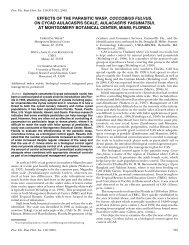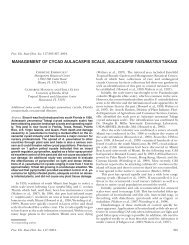Glossary of terms used in cycad systematics - Cycad Specialist Group
Glossary of terms used in cycad systematics - Cycad Specialist Group
Glossary of terms used in cycad systematics - Cycad Specialist Group
You also want an ePaper? Increase the reach of your titles
YUMPU automatically turns print PDFs into web optimized ePapers that Google loves.
Walters & Osborne – <strong>Cycad</strong> Classification: Concepts & Recommendations, Appendix 2 11<br />
hypocotyl. Embryonic axis at the time <strong>of</strong> seed germ<strong>in</strong>ation; that part from which the first leaf emerges.<br />
See also radicle.<br />
hypodermis. Cellular layer immediately <strong>in</strong>ternal to an epidermis.<br />
hypogeous. Occurr<strong>in</strong>g below soil level; subterranean, as for the stems <strong>of</strong> Stangeria eriopus, many Zamia<br />
species and most Macrozamia Section Parazamia species. Cf. epigeous.<br />
hypostomatic. Of leaves and leaflets with stomata on the abaxial surfaces only. Cf. amphistomatic.<br />
ICBN. International Code <strong>of</strong> Botanical Nomenclature, e.g. St Louis Code <strong>of</strong> 2000.<br />
idioblast. Specialized cell with <strong>in</strong>clusions, <strong>in</strong> <strong>cycad</strong>s stor<strong>in</strong>g tox<strong>in</strong>s possibly as a herbivore deterrent; a<br />
cell without known function.<br />
imbricate. Overlapp<strong>in</strong>g, as for leaflets <strong>of</strong> many Encephalartos species. See also <strong>in</strong>cubous, succubous.<br />
imparip<strong>in</strong>nate. Of a leaf or leaflet where the rachis or rachilla term<strong>in</strong>ates <strong>in</strong> a solitary p<strong>in</strong>na or p<strong>in</strong>nule.<br />
Cf. parip<strong>in</strong>nate<br />
<strong>in</strong>certae sedis. Of uncerta<strong>in</strong> placement <strong>in</strong> a classification system.<br />
<strong>in</strong>cubous. Arrangement <strong>in</strong> which a leaflet partially shields the leaflet above (the next distal leaflet) when<br />
viewed from above (adaxially). Cf. succubous.<br />
<strong>in</strong>curved. With apex bent or curv<strong>in</strong>g adaxially. Cf. recurved.<br />
<strong>in</strong>determ<strong>in</strong>ate. With growth <strong>of</strong> the axis cont<strong>in</strong>u<strong>in</strong>g <strong>in</strong>def<strong>in</strong>itely. Cf. determ<strong>in</strong>ate.<br />
<strong>in</strong>dumentum. Cover<strong>in</strong>g <strong>of</strong> trichomes or scales. See also tomentum.<br />
<strong>in</strong>editus, <strong>in</strong>ed. Unpublished, <strong>of</strong>ten <strong>in</strong> reference to an anticipated new species description.<br />
<strong>in</strong>erm. Without sp<strong>in</strong>es or prickles; unarmed, as for the leaves <strong>of</strong> Zamia <strong>in</strong>ermis. Cf. armed.<br />
<strong>in</strong>flexed. Bent longitud<strong>in</strong>ally <strong>in</strong>wards (adaxially) as <strong>in</strong> emerg<strong>in</strong>g leaves <strong>of</strong> many Zamia species. See also<br />
circ<strong>in</strong>ate, conduplicate, <strong>in</strong>flexed, ptyxis, reflexed, vernation.<br />
<strong>in</strong>sertion angle(s). See leaflet angle(s) <strong>of</strong> <strong>in</strong>sertion.<br />
<strong>in</strong>tegument. Outer cover<strong>in</strong>g <strong>of</strong> an ovule, form<strong>in</strong>g the layers <strong>of</strong> seed coat at maturity. See also sarcotesta,<br />
sclerotesta.<br />
<strong>in</strong>terstitial region. Interven<strong>in</strong>g zone between areas <strong>of</strong> def<strong>in</strong>ed structure.<br />
<strong>in</strong>volute. With marg<strong>in</strong>s rolled <strong>in</strong>wards (adaxially). Cf. revolute.<br />
isoenzymes, isozymes. Differ<strong>in</strong>g molecular forms <strong>of</strong> an enzyme that serve the same function.<br />
isotype, iso. Herbarium specimen that is a duplicate <strong>of</strong> (hav<strong>in</strong>g the same collection details as) the<br />
holotype. This term also has other applications, e.g. <strong>in</strong> immunology. See also lectotype, neotype,<br />
paratype.






